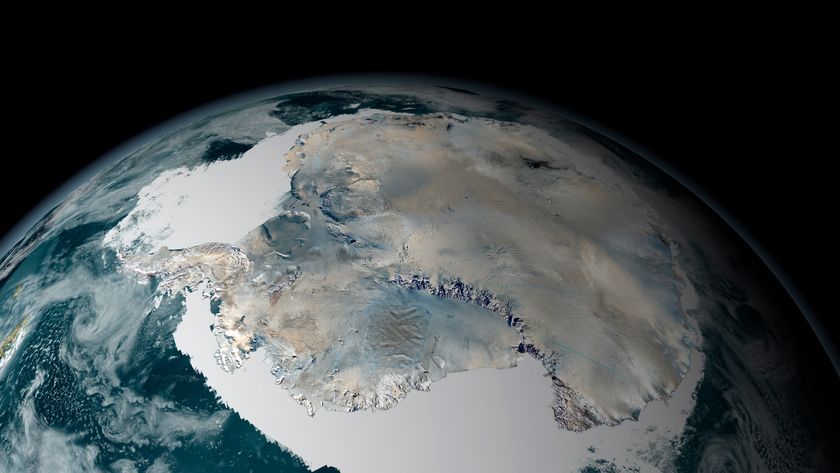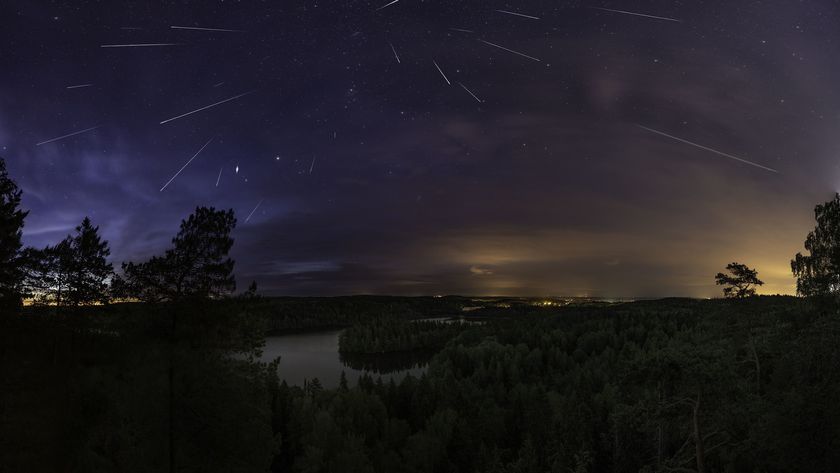Ancient Meteorite Impact Shattered Santa Fe

On a winding road near Santa Fe, New Mexico, exposed mountain walls form an intricate mosaic of brown, yellow, pink and grey rocks that stretch up toward the deep blue sky. To the untrained eye, these rocks are just a random jumble of different shapes and colors. To a geologist, however, such rock outcrops can tell a compelling story about the distant past.
One particular outcrop on this Santa Fe mountain pass whispers a thrilling tale of ancient cataclysmic violence.
Evidence suggests that a large meteorite smashed into this area long ago. The force of the impact shattered the ground and tossed broken and pulverized rocks far and wide. [Earth's Meteor Craters]
Scientists are currently studying the Santa Fe impact structure to determine when this event took place. Right now they can only say the meteorite struck sometime between 1.2 billion and 330 million years ago. Certainly it happened far enough in the past for the impact crater to "be completely altered or eroded.
Complicating the question is the "Great Unconformity," an event that wiped about a billion years of history out of the geologic record of this region. The disappearance of these tons of rocks was due to erosion — seas receded, and the newly exposed rocks wore away through wind, rain and other weathering processes. Then the seas flooded in again and sediments began forming new layers.
The result is that a 330-million-year-old rock layer now lies directly on top of rocks that vary between 1.2 to 1.6 billion years old, depending on the location.
Whenever the impact occurred, scientists estimate the crater it carved out of the Earth was once between 6 to 13 kilometers in diameter. This makes it much larger than a more famous impact crater in this region: the 1.2 kilometer-wide Meteor Crater in Arizona.
Sign up for the Live Science daily newsletter now
Get the world’s most fascinating discoveries delivered straight to your inbox.
This Preview is for a Select Audience
Most of the time, geologists study impact craters by digging a hole down into the base of the crater floor. They cut out a cylinder of rock, known as a "core," that is typically a few inches in diameter and several feet long. The rock layers of a core can give scientists a general idea of what the ground looks like deep beneath their feet.
Compared to the limited view of a core sample, the exposed rocks on the Santa Fe mountain road are an enormous movie screen that projects a 3-D feature of the aftermath of an impact.
Such impact crater cross-sections are extremely rare in the world,” says Horton Newsom of the University of New Mexico’s Institute of Meteoritics. Newsom and his colleagues, Shawn Wright and Wolf Elston, recently organized a public field trip to investigate the Santa Fe impact structure and the surrounding area. (Details on this and future trips can be found at http://epswww.unm.edu/sftrip/)
Because of the lack of a classic crater, geologists might never have known an impact occurred here if not for the fortuitous rock exposure. The key pieces of evidence for impact are the numerous "shatter cones” in what is thought to be the bedrock beneath the crater floor.
These cone-shaped rocks each have distinctive wavy patterns, as though the rock itself briefly became a flowing liquid before re-solidifying. Aside from underground nuclear explosions, shatter cones only form through the instantaneous hypervelocity force of a meteorite impact.
In addition to the puzzle created by the "Great Unconformity,” knowledge about the history of impacts in the southwestern United States is incomplete because the region has experienced a lot of volcanism over the ages. Volcanoes tend to wipe away surface features like impact craters, the fresh lava and tectonic activity obliterating evidence the craters ever existed. One reason Meteor Crater is so well preserved is because it is relatively young, having formed only about 50,000 years ago.
Volcano versus Meteorite
Another problem with studying impact craters in volcanic regions is figuring out if a crater was shaped by an extraterrestrial projectile, or if instead it was formed by a violent volcanic eruption. Despite the different methods of creation, the features can look remarkably similar.
How can scientists tell the difference between one round hole in the ground that was made by the inward punch of a meteorite, versus another round hole made by the outward explosion of underground gas and lava?
The Jemez volcanic field near the Santa Fe impact structure provides a conveniently close point of comparison. The field has a ring of several dormant volcanic mountains that are now green with trees and other vegetation.
Most of the volcanic activity here occurred between 1.6 million to 600 thousand years ago, with the last known eruption about 50 thousand years ago (although another volcanic eruption could feasibly happen again sometime in the future).
Besides looking for tell-tale shatter cones, scientists can compare mixtures of broken rock, or "breccia,” associated with the different features.
One of the volcanoes, for instance, produced Battleship Rock ignimbrite, a tall conglomeration of rubble that was once a hot cloud of particles and gases thrown out by the eruption. The impact structure also has large breccia mounds nearby. Differences in these rock towers can indicate what process made them.
For instance, Battleship Rock has an enormous slab of black obsidian glass that formed from cooling lava. Glasses also can form in the heat of a meteorite impact, but they tend to be tiny round blobs less than a centimeter in size. Such glass particles were found in a microscopic analysis of the Santa Fe impact structure shatter cones.
A History of Havoc
Volcanoes and impacts are Earth’s twin modes of destruction. Both can raise large tsunamis if they occur in or near an ocean. Both can alter the environmental conditions of the surrounding area, and also have global effects by sending huge amounts of pulverized rock and gas into the sky that blocks sunlight and alters the chemistry of the planet’s atmosphere.
A large meteorite that slammed into the Yucatan Peninsula 65 million years ago is blamed for the K-T mass extinction that ended the age of the dinosaurs. Volcanoes have not yet been linked to a mass extinction, but they have famously caused more localized catastrophes, such as when the eruption of Mount Vesuvius in 79 AD killed most of the residents of Pompeii.
Discerning the subtle differences between a volcanic crater and an impact crater is important for understanding Earth’s complex history. This knowledge also could be useful in our exploration of Mars. The surface of Mars is liberally dotted with impact craters, and the planet also has a history of volcanism; Olympus Mons, the largest mountain in the solar system, is a dormant volcano. Mars even may have volcanic activity taking place beneath its surface today.
Scientists studying the Santa Fe impact structure admit much more analysis needs to be done before they fully understand what happened all those years ago. They hope to better determine the size of the impact, and also the various effects it had on the basement rocks that underlie the missing crater.
"We need an army of scientists and graduate students studying this site, over many, many years,” notes Newsom. "It could take several lifetimes to do all the necessary work.”












